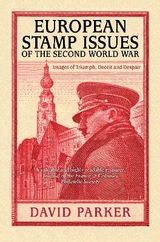
European Stamp Issues of the Second World War
Images of Triumph, Deceit and Despair
2015
The History Press Ltd (Verlag)
978-0-7509-5915-5 (ISBN)
The History Press Ltd (Verlag)
978-0-7509-5915-5 (ISBN)
- Titel erscheint in neuer Auflage
- Artikel merken
Zu diesem Artikel existiert eine Nachauflage
Today, European nations still use stamps to commemorate aspects of a nation’s culture, history and achievements. The glorification of the Führer and Germany on the stamps of countries he most oppressed was inevitable, but many issues are ambiguous and indicative of the rival ethnic and political forces striving to attain influence and power.
Today, European nations still use stamps to commemorate aspects of a nation’s culture, history and achievements. During the Second World War, however, stamps were considered far more important in conveying political and ideological messages about their country’s change in fortunes – whether it was as triumphant occupier, willing or unwilling ally, or oppressed victim. Some issues and overprints contained obvious messages, but many others were skillfully designed and subtle in their intentions. Stamps and their accompanying postmarks offer an absorbing and surprisingly detailed insight into the hopes and fears of nations at this tumultuous time. This remarkable collection examines and interprets the stamps of twenty-two countries across western and eastern Europe. The glorification of the Führer and Germany on the stamps of countries he most oppressed was inevitable, but many issues are ambiguous and indicative of the rival ethnic and political forces striving to attain influence and power. Desperate to unite the people, Soviet Russia resorted to images of the nation’s heroic achievements under the Tsars; the mutually hostile puppet states Hitler and Mussolini allowed to emerge out of conquered Yugoslavia lost no time in issuing stamps proclaiming their cultural diversity; and Vichy France sought to justify its existence with issues linking past glories under Louis XIV and Napoleon with an equally glorious future alongside Hitler. These and many more stories reveal the aspirations, assumptions and anxieties of so many nations as their destinies hung in the balance.
Today, European nations still use stamps to commemorate aspects of a nation’s culture, history and achievements. During the Second World War, however, stamps were considered far more important in conveying political and ideological messages about their country’s change in fortunes – whether it was as triumphant occupier, willing or unwilling ally, or oppressed victim. Some issues and overprints contained obvious messages, but many others were skillfully designed and subtle in their intentions. Stamps and their accompanying postmarks offer an absorbing and surprisingly detailed insight into the hopes and fears of nations at this tumultuous time. This remarkable collection examines and interprets the stamps of twenty-two countries across western and eastern Europe. The glorification of the Führer and Germany on the stamps of countries he most oppressed was inevitable, but many issues are ambiguous and indicative of the rival ethnic and political forces striving to attain influence and power. Desperate to unite the people, Soviet Russia resorted to images of the nation’s heroic achievements under the Tsars; the mutually hostile puppet states Hitler and Mussolini allowed to emerge out of conquered Yugoslavia lost no time in issuing stamps proclaiming their cultural diversity; and Vichy France sought to justify its existence with issues linking past glories under Louis XIV and Napoleon with an equally glorious future alongside Hitler. These and many more stories reveal the aspirations, assumptions and anxieties of so many nations as their destinies hung in the balance.
Dr David Parker is a retired history lecturer. In the 1990s he led EU projects on education in the new Czech Republic. He is the author of "The People of Devon in the First World War," andhis collection of stamps from World War IIhas been amassed over many decades."
| Erscheint lt. Verlag | 4.5.2015 |
|---|---|
| Zusatzinfo | 48 Plates, color; 100 Illustrations, color; 250 Illustrations, black and white |
| Verlagsort | Stroud |
| Sprache | englisch |
| Maße | 156 x 234 mm |
| Themenwelt | Sachbuch/Ratgeber ► Freizeit / Hobby ► Sammeln / Sammlerkataloge |
| Geschichte ► Teilgebiete der Geschichte ► Militärgeschichte | |
| ISBN-10 | 0-7509-5915-0 / 0750959150 |
| ISBN-13 | 978-0-7509-5915-5 / 9780750959155 |
| Zustand | Neuware |
| Haben Sie eine Frage zum Produkt? |
Mehr entdecken
aus dem Bereich
aus dem Bereich
neueste Manipulationstechniken als Waffengattung der NATO
Buch | Softcover (2023)
Westend (Verlag)
CHF 33,55
Deutschlands Schwäche in der Zeitenwende
Buch | Softcover (2023)
C.H.Beck (Verlag)
CHF 25,20



